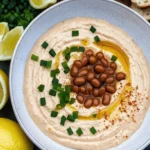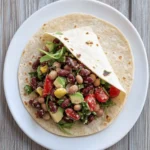A flavorful and hearty shrimp fried rice dish inspired by hibachi-style cooking. This dish combines juicy shrimp, fluffy rice, vegetables, and savory seasonings, all stir-fried on a hot surface to create a smoky, delicious meal perfect for lunch or dinner.
FULL RECIPE
Ingredients
- 1 lb large shrimp, peeled and deveined
- 3 cups cooked jasmine rice (preferably day-old)
- 2 tablespoons vegetable oil
- 1 tablespoon sesame oil
- 2 eggs, beaten
- 1 cup diced onion
- 1 cup mixed vegetables (carrots, peas, corn)
- 3 cloves garlic, minced
- 2 tablespoons soy sauce
- 1 tablespoon oyster sauce
- 1 teaspoon black pepper
- 2 green onions, sliced
- Salt to taste
Directions
- Heat vegetable oil on a griddle or large skillet over medium-high heat.
- Add shrimp and cook for 2–3 minutes on each side until pink and opaque. Remove and set aside.
- Add sesame oil, then sauté diced onion and garlic for 1–2 minutes until fragrant.
- Push vegetables to the side, pour in beaten eggs, and scramble until cooked.
- Add the cooked rice and mixed vegetables, stir-frying everything together for 3–4 minutes.
- Return shrimp to the pan and mix in soy sauce, oyster sauce, and black pepper.
- Stir everything thoroughly until well combined and heated through.
- Garnish with sliced green onions and serve hot.
Nutritional Information
- Calories: 420 per serving
- Protein: 25g
- Carbohydrates: 40g
- Fat: 18g
- Fiber: 3g
- Sodium: 800mg
History and Origin of Shrimp Fried Rice
Shrimp fried rice is a classic dish with roots tracing back to Chinese cuisine, where fried rice dishes were originally created as a way to use leftover rice and ingredients. Over time, this dish evolved across Asia, gaining various regional adaptations. The addition of shrimp brings a coastal flair, reflecting the abundance of seafood in many Asian countries. Today, shrimp fried rice is enjoyed worldwide, often featured in hibachi-style cooking in American Japanese restaurants.
The Role of Jasmine Rice in the Recipe
Jasmine rice is the preferred rice for this dish due to its fragrant aroma and slightly sticky texture, which holds together without becoming mushy. Using day-old jasmine rice helps ensure that the grains remain separate when fried, preventing clumping and achieving the ideal texture that defines great fried rice.
Why Day-Old Rice Works Best
Freshly cooked rice tends to be moist and soft, which can lead to a sticky fried rice outcome. Day-old rice dries out slightly in the refrigerator, making it firmer and less likely to clump. This dryness allows the rice to absorb flavors better and fry evenly without becoming mushy or gummy.
The Importance of High Heat Cooking
Frying shrimp fried rice at high heat is key to developing its characteristic smoky flavor known as “wok hei.” This heat ensures quick cooking, sealing in juices of the shrimp and crisping the rice grains. Using a griddle or wok can simulate the traditional hibachi method, creating a more authentic taste and texture.
Shrimp Selection and Preparation Tips
Choosing fresh, large shrimp that are peeled and deveined makes a big difference in flavor and ease of cooking. Deveining removes the digestive tract, improving texture and taste. Properly drying shrimp before cooking prevents them from steaming and helps achieve a nice sear.
Vegetable Choices and Their Impact on Flavor
A mix of diced carrots, peas, and corn is common, adding color, crunch, and sweetness to balance the savory elements. These vegetables are quick to cook and maintain their texture, providing contrast to the soft rice and tender shrimp.
The Role of Aromatics in Shrimp Fried Rice
Garlic and onions form the aromatic base, releasing fragrant oils that infuse the entire dish with depth and complexity. These aromatics also enhance the savory qualities of soy and oyster sauce, elevating the overall flavor profile.
Eggs in Fried Rice: More Than Just a Protein
Scrambled eggs add a rich, creamy texture that complements the other ingredients. They also help bind the rice together lightly, making each bite satisfying. The eggs introduce a subtle sweetness and provide additional nutritional value.
Balancing Soy Sauce and Oyster Sauce
Soy sauce adds saltiness and umami, while oyster sauce contributes a subtle sweetness and richness. The combination creates a harmonious flavor, ensuring the dish is neither too salty nor too bland.
Sesame Oil’s Contribution to Flavor
Sesame oil is added towards the end for its nutty aroma and flavor, which gives shrimp fried rice its distinctive character. Using it sparingly prevents overpowering the dish but enhances the overall complexity.
The Significance of Green Onions
Green onions provide a fresh, slightly sharp contrast to the rich and savory elements. Sprinkling them on top adds color and a burst of brightness that lightens each mouthful.
Common Variations of Shrimp Fried Rice
Many variations exist, including adding pineapple for sweetness, cashews for crunch, or chili for heat. Some versions use different proteins like chicken or tofu, making it adaptable to diverse tastes and dietary needs.
Health Considerations
While shrimp fried rice is flavorful and filling, it can be high in sodium and fat depending on sauces and oils used. Using reduced-sodium soy sauce and moderate oil can make it a healthier option. Including plenty of vegetables boosts fiber and nutrient content.
Pairing Shrimp Fried Rice with Other Dishes
Shrimp fried rice pairs well with light soups, steamed vegetables, or a crisp salad to balance the meal. It can also complement grilled meats or seafood in a larger spread, making it versatile for any occasion.
Storing and Reheating Leftovers
Shrimp fried rice can be stored in an airtight container in the refrigerator for up to three days. When reheating, using a hot pan and adding a splash of water or oil helps refresh the rice’s texture and prevents drying out.
Tips for Making Shrimp Fried Rice at Home
Using pre-cooked or leftover rice is essential, and prepping all ingredients before cooking ensures a smooth process. Avoid overcrowding the pan to maintain high heat and proper frying. Experimenting with seasonings allows customization to personal taste.
Cultural Significance in Asian Cuisine
Fried rice dishes symbolize resourcefulness and family-style meals in many Asian cultures. They represent a way to bring together leftovers into a delicious new dish, often enjoyed communally.
Shrimp Fried Rice in Hibachi Cooking
Hibachi chefs emphasize quick, high-heat cooking with flair, often preparing shrimp fried rice right before guests. The theatrical element combined with skillful seasoning enhances the dining experience.
Environmental and Sustainability Aspects of Using Shrimp
Opting for sustainably sourced shrimp supports ocean health and responsible fishing practices. Awareness of shrimp farming impacts encourages consumers to make environmentally conscious choices.
Conclusion
Shrimp fried rice is much more than a simple dish; it is a harmonious blend of textures, flavors, and cultural traditions. Its adaptability and ease of preparation make it a favorite for home cooks and professional chefs alike. By understanding the ingredients, cooking techniques, and variations, anyone can create a delicious shrimp fried rice that satisfies both the palate and the soul. Whether enjoyed as a quick weeknight meal or a feature at a festive gathering, shrimp fried rice continues to be a beloved culinary classic worldwide.






